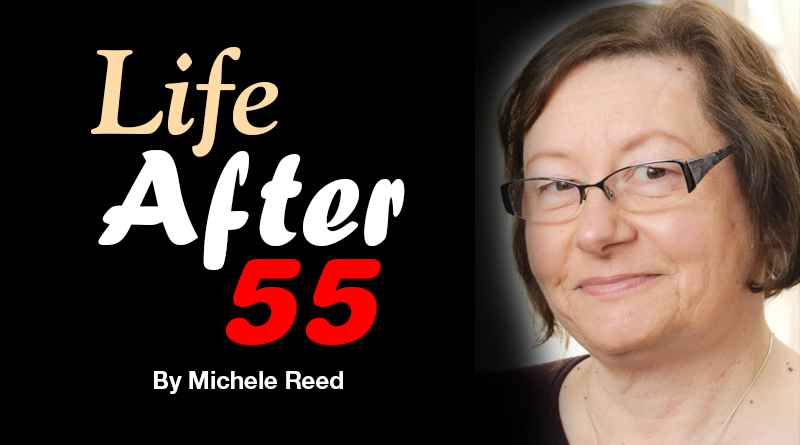Going Broke at the Brocante
By Michele Reed
michele@cny55.com
Photos by Bill Reed
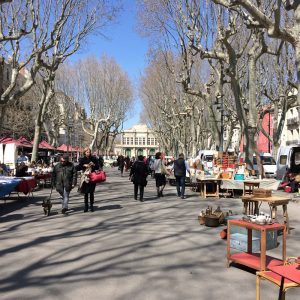
Anyone who knows me, knows that I love a bit of antiques hunting — or junk shopping, as my husband Bill sometimes characterizes it.
The Paris flea markets are world famous, and visiting them is a once-in-a-lifetime experience for many Americans. But imagine our surprise when we moved to France and found our city of Béziers is home to not one, but two weekly brocante markets.
Every Tuesday and Saturday, we can wander the stalls, in the shade of the plane trees on the Allées Paul Riquet, marveling at Art Deco furniture, comic books of Tintin and Asterix the Gaul and 18th-century French porcelain.
The French have various venues for seeking out old objects. At the bottom of the food chain is the vide grenier, which literally means “empty the attic.” On a given day, the village declares a vide grenier, and everyone drives up to a central plaza or a large parking lot, sets out a table or blanket, and sells all manner of used goods from their homes. You can find used children’s clothes and games, dishware, lawn chairs and books, with the occasional antique treasure thrown in.
In our area, each village has the vide grenier on a different weekend in spring and fall. Flyers are posted in neighboring villages and people plan their weekends traveling from town to town, taking in the sales. Lucky for our wallets (and the limited square footage of our house), we don’t have a car to travel to the various villages, and so any purchases would be limited by what we can carry on the bus.
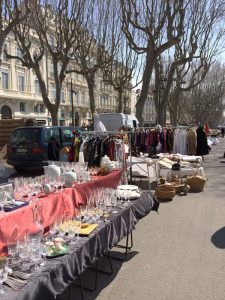
A step up from the vide grenier is the marché de puce, literally the flea market. Usually these include regular dealers who travel from village to village and set up at flea market day or the weekly farmers’ market, and sell everything from mismatched silverware and used videos to 1970s macramé planters.
At the top end are antique dealers, who command top dollar. In addition to their classy shops and galleries, they also sell at several fairs, usually in the larger cities.
Nestled between the marché de puce and the high-end antiquing fairs is the brocante, a kind of hybrid of all the other venues. The word refers both to the market and the objects for sale.
In Béziers, our Tuesday fair tends to be a little more refined, and there are a few dealers who have quality furniture, including Art Deco and 17th- and 18th-century pieces.
On Saturday, the offerings are a bit less expensive, with plenty of glassware from bars and cafés, comic books and toy cars, and restoration hardware to choose from.
Because our typical three-month sojourn in France gives us plenty of opportunities to shop the brocante, we often just browse the booths waiting for that perfect treasure.
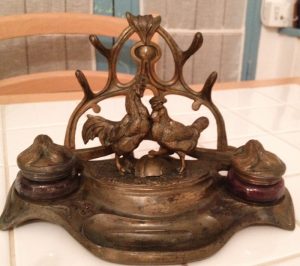
We’ve found them more than once. My writing desk now sports an Art Deco leaping deer pen and ink stand from carved wood. A brocante about a year later yielded two matching bookends.
Another inkstand we found is made from molded brass and signed by Louis Navatel Vidal (1831-1892). It has two chickens, a traditional symbol of France. The French were originally the Gauls and the Latin word gallus referred to the Gauls and also meant rooster, hence the moniker. You can see the symbol of the coq used today for France’s sports teams, including the men’s and women’s World Cup Soccer teams, Les Bleues (so called for their blue jerseys).
The French take their food seriously and so they have different dishes for specific types of food. When Bill found some plates in one of our favorite Longchamps patterns, we didn’t mind they had a little divider. The brocantiste explained that they were asparagus plates from the 1920s and the smaller section was for sauce to dip the asparagus in. It’s not unusual to find century-old dishware at the brocante!
Bill has a great eye for spotting our favorite patterns from 20 feet away, and his negotiating skills mean we get a good bargain. The only downside? A heavy load for him to carry on the bus!
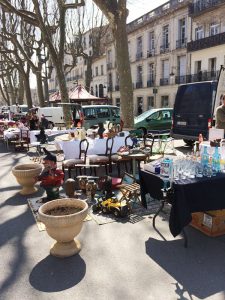
Speaking of negotiating, bargaining with brocante dealers is great way to hone our French skills — now that we know our numbers fast enough to think on our feet! There are specific rules: First both sides must say “Bonjour,” and no touching the objects until they’re handed to you. Bill has perfected the dismissive wave accompanied by a “Pah!” sound that French shoppers use when a price is too high.
And as with any adventure on Béziers’ Allées, the shopping concludes with a relaxing lunch or drink at the cafés which are only steps away.

